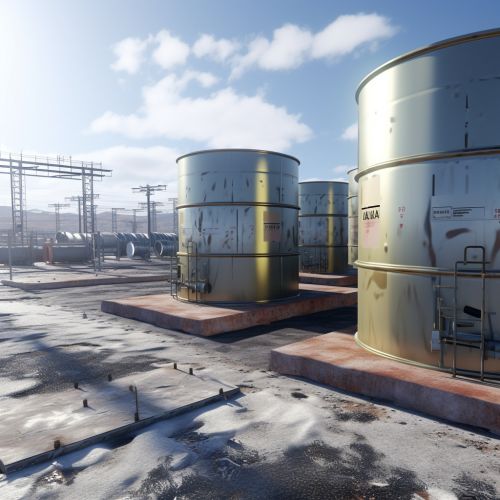Radioactive Waste
Introduction
Radioactive waste is a type of hazardous material that contains radioactive chemical elements. It is a byproduct of various activities, including nuclear power generation, nuclear fission or nuclear technology used in medicine, and scientific research. The handling and disposal of radioactive waste present significant challenges due to its harmful effects on human health and the environment.


Types of Radioactive Waste
Radioactive waste can be classified into three main categories based on its level of radioactivity: low-level waste (LLW), intermediate-level waste (ILW), and high-level waste (HLW).
Low-Level Waste
Low-level waste (LLW) includes items that have been contaminated with radioactive material or have become radioactive through exposure to neutron radiation. This waste typically includes paper, rags, tools, clothing, filters, and other materials which contain small amounts of mostly short-lived radioactivity.
Intermediate-Level Waste
Intermediate-level waste (ILW) contains higher amounts of radioactivity and in some cases requires shielding. ILW typically includes resins, chemical sludges, and metal fuel cladding, as well as contaminated materials from reactor decommissioning.
High-Level Waste
High-level waste (HLW) is produced by nuclear reactors. It contains the fission products and transuranic elements generated in the reactor core. HLW is highly radioactive and often thermally hot. HLW accounts for over 95% of the total radioactivity produced in the process of nuclear power generation.
Sources of Radioactive Waste
Radioactive waste comes from a number of sources. The majority of waste originates from the nuclear fuel cycle and nuclear weapons reprocessing. Other sources include medical and industrial wastes, as well as naturally occurring radioactive materials (NORM).
Nuclear Fuel Cycle
The nuclear fuel cycle is the series of industrial processes which involve the production of electricity from uranium in nuclear power reactors. The cycle starts with the mining of uranium and ends with the disposal of nuclear waste. Waste produced includes uranium mill tailings, spent (used) reactor fuel, and other types of waste.
Nuclear Weapons Reprocessing
Nuclear weapons reprocessing is a method used to chemically treat spent fuel to extract valuable elements that can be reused. The byproduct of this process is a highly radioactive waste stream.
Medical and Industrial Waste
Radioactive waste is generated during various applications such as use in medical, industrial, and scientific processes. These wastes could be in the form of contaminated materials and equipment, or directly as a result of experiments and treatments.
Naturally Occurring Radioactive Materials
Naturally occurring radioactive materials (NORM) are ubiquitous in the environment. Certain industrial activities may concentrate these materials in a way that could pose a risk to human health. The waste generated from these activities is known as Technologically Enhanced Naturally Occurring Radioactive Material (TENORM).
Management of Radioactive Waste
The management of radioactive waste requires specialized technology and facilities. The goal is to protect human health and the environment from the harmful effects of radiation in present and future times. The main approaches to managing radioactive waste have been segregation and containment, transmutation, and disposal.
Segregation and Containment
Segregation involves separating waste into categories based on its type, radioactivity, and other factors. Containment is the process of enclosing the waste in a suitable container to prevent the spread of radioactivity.
Transmutation
Transmutation is the process of changing the physical and chemical properties of the waste to make it less harmful or easier to handle. This can be achieved through various methods, including thermal treatment, compaction, and encapsulation.
Disposal
Disposal of radioactive waste is the final step in the waste management process. This involves isolating the waste from the biosphere in a suitable disposal facility. The type of disposal facility used depends on the type of waste. Low-level waste is typically disposed of in near-surface facilities, while high-level waste requires deep geological repositories.
Impact on Environment and Human Health
Radioactive waste poses a significant risk to the environment and human health. Exposure to radiation can result in harmful effects such as cancer and genetic damage. The environmental impact includes contamination of soil and water bodies, and harm to wildlife.
Legislation and Regulation
The management of radioactive waste is heavily regulated by international and national laws. These laws set out the requirements for the safe handling, treatment, storage, and disposal of radioactive waste. They also set out the responsibilities of waste producers and regulatory bodies.
